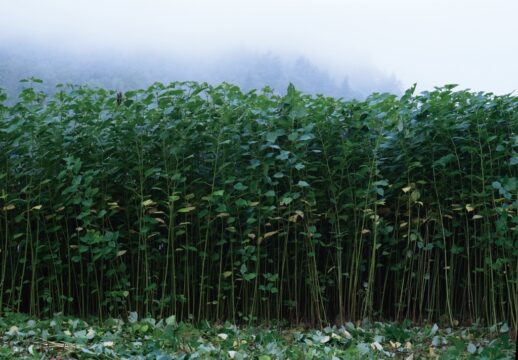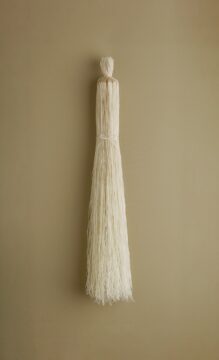
2023/11/3 (Friday) – 2024/1/28 (Sunday)
Ryohin Keikaku Co., Ltd., which operates MUJI, will hold an exhibition at ATELIER MUJI GINZA Gallery 1 and 2 in MUJI Ginza (Chuo-ku, Tokyo) from Friday, November 3, 2023 to Sunday, January 28, 2024. We will be holding a special exhibition titled “Tracing the Origin of Materials: 'Ferry Boats – The Work of Karamushi''.
Many of the traditional crafts that have been passed down throughout the world are facing various challenges as the times change, such as changes in lifestyles, the aging of creators, and a lack of successors. “Tracing the origins of materials'' means, while facing various issues, focusing on the materials and makers who use the same raw materials and traditional techniques as before, understanding the background, and carefully transmitting the culture. This is an initiative to introduce manufacturing that leads to empathy and the creation of new value.
This time, as the first article, we will be taking a look at Karamushi weaving, which is made from the fibers of a plant called “Karamushi'', also known as ramie (ramie). Karamushi is a material similar to linen, and has good moisture absorption and quick-drying properties, making it a good material for summer clothing and has also been used as a raw material for high-end textiles.
This special exhibition consists of three themes, and displays the method of karamushi cultivation that has been passed down since ancient times, along with photographs of the seasonal rich natural scenery of Showa Village, Fukushima Prefecture, and the tools used during cultivation. Insect Cultivation'', a recreation of the “Ferry Boat'' atelier by Etsuko Watanabe and Yukiko Funaki, who are active in exploring the potential of Karamushi in Showa Village, Fukushima Prefecture, and the process of weaving Karamushi into thread and weaving cloth. “Ferryboat – Karamushi's work'' introduces the activities of ferryboats, with an exhibition of the tools actually used in the process, explores the possibilities of karamushi, and as one of them, the fusion of karamushi and the field of art. In the experiment, “Exploring the future of Karamushi,'' we will display tapestries and other items dyed by the indigo dyeing group BUAISOU., featuring designs by dyer Sayaro Yuzuki on Karamushi cloth.
We aim to create an exhibition that connects the past, present, and future of manufacturing by proposing future possibilities based on the background of materials' creation.
"Karamushi" is a perennial plant of the nettle family, also called choma. Karamushi has been cultivated in Showa Village, Fukushima Prefecture since at least the Edo period. The quality of Karamushi produced in this village is particularly high, and it has been prized as a raw material for the finest textiles such as “Echigo Jofu'' and “Ojiya Chijimi''. However, due to changes in lifestyle and depopulation, fewer people were able to pass on the skills that had been passed down from generation to generation. He applied for the Karamushi Weaving Experience Student “Orihime Hikoboshi'' project, which was started to protect the Karamushi in this historic village, and was fascinated by the work of Karamushi, and continued to live with the Karamushi in Showa Village. Etsuko Watanabe and Yukiko Funaki). From cultivation to harvesting to weaving, we use traditional methods to create products that reflect the changing seasons. The current exhibition consists of three parts: “Cultivation of karamushi rooted in the seasons,'' “Ferryboat – Karamushi activities,'' and “Exploring the future of karamushi.'' Through this exhibition, we hope that by learning about the splendor of materials created using traditional techniques and the interaction with nature that ferryboats reveal, we will be able to think about our future lives and society.
ATELIER MUJI GINZA
【basic information】
“Ferryboat – Karamushi's work'' tracing the origin of materials Exhibition period | Friday, November 3, 2023 – Sunday, January 28, 2024
Business hours|11:00-21:00
Venue | MUJI Ginza 6F ATELIER MUJI GINZA Gallery 1 and 2 Free admission
*Closed hours are subject to store closures. Some exhibits may not be available for viewing due to schedule changes or events.
Sponsored and planned | Ryohin Keikaku Co., Ltd. Exhibition cooperation | Ferry boat (Etsuko Watanabe, Yukiko Funaki)
Spatial composition | Masafumi Tashiro graphic design | Akina Morita video editing/sound | Satoshi Kasuga video | Cooperation with the documentary film "Voices of Karamushi" (directed by Daitsubasa Bundo/produced and written by National Museum of Japanese History/2019) | Reiko Sudo / Sayaro Yuzuki / BUAISOU. / National Museum of Japanese History Construction|HIGURE 17-15 cas
ATELIER MUJI GINZA
3-3-5 MUJI Ginza 6F, Ginza, Chuo-ku, Tokyo 104-0061
Access | 3 minutes walk from Exit B4 of Ginza Station on the Tokyo Metro Ginza Line, Marunouchi Line, and Hibiya Line 3 minutes walk from Exit 5 of Ginza 1-chome Station on the Tokyo Metro Yurakucho Line
5 minutes walk from the central exit of Yurakucho Station on the JR Yamanote Line
ATELIER MUJI GINZA official website|https://atelier.muji.com/jp/
Instagram|@ateliermuji_ginza
[Related events]
We are planning to hold events during this exhibition. Details and application information will be announced on the ATELIER MUJI GINZA official website and SNS.
[Ryohin Keikaku Co., Ltd.] From a press release
<Past related articles>
Announcement of ATELIER MUJI special exhibition Life in Art "JAPAN CRAFT 'Design of 100 craftsmen' exhibition"
Announcement of the ATELIER MUJI exhibition “small MUJI” and “Beloved Japanese sweets” exhibition





